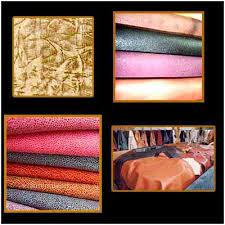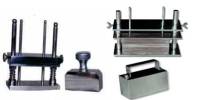Garment leather can be divided into the following types-
• Fur garments leather
• Grain garment leather
• Suede garment leather
Fur garment leather:
This is generally made from sheep skin with fine wool. Among fur garment leathers there are two varieties available viz. “Hair-on leather” and “Double Face fur skin leather”. In the case of hair-on, emphasis is given only on hair or fur and processing is carried out to make the fur soft, lustrous etc. In the case of Double face fur skin, both fur side and flesh side can be used.
Grain garment leather:
This category leathers are finished on the grain side either by resin or protein .They are usually made from red hair sheep skins or wool sheep skins. Nowadays, these are made from goat skins and cow sides also such as Nappa.
Suede garment leather:
A term taken from the French, “gants de Suede” (Swedish gloves), and applied to a leather finished on the flesh side by buffering so as to raise a velvet-like nap. The typical suede leather is produced from the smaller skins, such as calfskin, kidskin, lambskin and goatskin, although cowhide has also been used.
The nap is produced by buffing or wheeling the surface on the flesh side, or the split side of flesh splits; velvet suedes, however, are buffed on the grain side. A common criterion of good suede leather is that the fibers of the nap should be of uniform length and tightly packed together, in order to give resilience to the nap so that it does not readily shown finger marks. The firmness of the nap depends upon the density and compactness of the fiber structure. Velvet suedes are finer than flesh suedes and a younger animal, such as a slunk, produces even finer suede.
A principal concern in making suede leather is to retain the fine nap and still produce soft leather; however, the leather must not be made soft by means of improper fatliquoring , because even a small excess of oil will produce a greasy suede nap.
BASIC CHARACTERISTIC PROPERTIES OF GARMENTS LEATHER
• Drape,
• Softness,
• Naps,
• Surface smoothness,
• Lightness in weight,
• Light fastness,
• Wet and dry rub fastness,
• Fastness to washing,
• Fastness in dry cleaning,
• Perspiration resistance,
• Uniformity in shade,
• Shower proofness,
• Stitch tear resistance,
• Tongue tear resistance.
Drape:
This is the most important characteristic of garment leather, as it contributes to wear comfort. This property deals with the ability of the leather to fall like textile so as to take the shape of the body when worn.
Softness:
The clothing leather should be soft without any bony feel. This property can be achieved by modifying the possessing techniques. The present day fashion demands better soft leather for garment.
Nap:
This is the most important characteristic by which the suede garment leathers are judged. These leathers should have a short, tight and velvety nap which is achieved by proper retanning techniques.
Surface smoothness:
This is an important property for grain garment leathers and a verity of chemicals under the tough modifiers and slip agents category are available to impart this property to the leathers.
Light fastness:
The garment is exposed to different weather condition when worn. The color of the garment should not change when exposed to the vagaries of the weather. The chemicals used for processing, particularly dyestuffs and retanning agents play a vital role in achieving this property.
Wet and dry rub fastness:
This is another important property of garment leather. In the case of grain garment leather, the finish should have good protective top coat to prevent the color coming off from the leather when rubbed with a dry cloth. In the case of suede’s the bleeding of the dye is prevented by using different kinds of fixatives.
Fastness to washing:
This property depends upon the type of tannage and dyestuff employed for production of garment leathers. Leathers processed by chrome glutaraldehyde combination tannage and dyed with reactive dyes comparatively possess greater fastness.
Fastness to dry cleaning:
The garment leather should stand the treatment with solvents to remove greasy stains. During this treatment, the color of the leather should not change or should not shrink and become hard. To achieve this property, selection of dyestuff and fat liquor are very crucial.
Perspiration Resistance:
The leather should be capable of absorbing and transmitting the perspiration without staining / soiling the leather. Treatment with glutaraldehyde is always beneficial in achieving this property.
Uniformity in shade:
This property depends on tanning and post tanning operations and is essential for garment leathers where the different panels of the garment should have uniformity in shade even when cut from different leathers.
Shower proofness:
This is very much essential for suede garment leathers, because during drizzle / shower, the leather should not get wet lest the color will run. To achieve’ this objective shower proofing chemicals, water resistance/repellant chemicals are available and judicious choice of these enables the suede leather achieve this property.
Stitch tear resistance:
Generally the stitch tear resistance should be good in the garment leathers. Garment leathers made from Indian origin sheep skins have better stitch tear resistance compared to sheep skins like merinos and merinos cross breeds.
Tongue tear resistance:
This is also important property of garment leather. Tear resistance also is good in the Red Hair sheep skins.
















